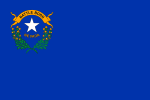The Las Vegas Valley is a major metropolitan area in the southern part of the U.S. state of Nevada, and the second largest in the Southwestern United States. The state's largest urban agglomeration, the Las Vegas Metropolitan Statistical Area is coextensive since 2003 with Clark County, Nevada. The Valley is largely defined by the Las Vegas Valley landform, a 600 sq mi (1,600 km2) basin area surrounded by mountains to the north, south, east and west of the metropolitan area. The Valley is home to the three largest incorporated cities in Nevada: Las Vegas, Henderson and North Las Vegas. Eleven unincorporated towns governed by the Clark County government are part of the Las Vegas Township and constitute the largest community in the state of Nevada.The names Las Vegas and Vegas are interchangeably used to indicate the Valley, the Strip, and the city, and as a brand by the Las Vegas Convention and Visitors Authority to denominate the region. The Valley is affectionately known as the "ninth island" by Hawaii natives and Las Vegans alike, in part due to the large number of people originally from Hawaii who live in and regularly travel to Las Vegas.Since the 1990s, the Las Vegas Valley has seen rapid growth, tripling its population from 741,459 in 1990 to 2,227,053 estimated in 2018. The Las Vegas Valley remains one of the fastest growing metropolitan areas in the United States. In its relatively short history, it has established a diverse presence in international business, commerce, urban development, and entertainment, as well as one of the most visited tourist attractions destinations in the world. In 2014, a record-breaking 41 million people visited the Las Vegas area, producing a gross metropolitan product of more than $100 billion.






